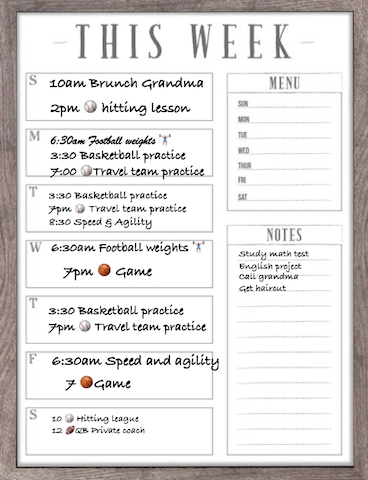The #LTADchat on Twitter
How to Participate in a Twitter Chat - Learn more in this video
Q1 How do you define or describe long-term athlete/athletic development?
Q2 Do you view the participation and the performance pathways as separate or parallel?
Q3 Do you consider LTAD and #physed as separate or inter-related entities? Explain.
Q4 Describe the LTAD efforts in your organization / club / school / community
Q5 So what makes a good plan for Awareness, Action, and Accountability for LTAD?
Q6 What are the biggest barriers to implementation of LTAD?
Click here for complete summary
Q1 How do you ensure the development of a proficient movement vocabulary?
Q2 'Underuse” has been identified as risk factor for injury… how do you ‘negotiate’ with others/coaches to incorporate S&C activities for injury prevention?
Q3 Both Pillars 2 & 5 focus on fitness, health and well-being. Most of us focus on physical aspects but what do you do to promote psycho-social development or #SEL in youth?
Q4 What are your biggest challenges associated with programming for youth?
Q5 Have you read the NSCA LTAD Position Statement word-for-word?
Q6 Is there anything missing (or needs to be edited) from the Pillars? If so, what?
Click here for complete summary
Phys Ed & LTAD Guest host: Peter Verdin
Q1 What are the differences between phys ed & LTAD?
Q2 What are 2 personal strengths & weaknesses related to LTAD and/or phys ed
Q3 How do you lesson plan or program and how could others benefit from key aspects of what you do?
Q4 What is your philosophical approach to teaching skills and ways you connect with kids?
Q5 What are your easiest to implement/ most impactful strategies for managing a group?
Q6 What is one misconception about LTAD/PE that you wish you could clear about your profession?
Click here for complete summary
Sports Specialization
Q1 How many sports did you play growing up?
Q2 How would you define early sports specialization?
Q3 If you specialized in a sport, at what age did you start to specialize? Were you pressured by a coach, parent, or someone else to specialize in that sport?
Q4 What do you see as the BIGGEST CULPRITS of early sports specialization?
Q5 What’s worse – single sport specialization with balanced workload or 2-3 sport athlete doing all sports nearly year-round?
Q6 What strategies and/or resources have you used to educate parents on sports sampling v. specialization?
Click here for complete summary
Q1 The fundamental movement skills (FMS) are often categorized into 3 categories. Do you agree with this schema? Is this how you think about FMS? What’s your perspective?
Q2 What does it mean to be technically proficient? And how do you assess ‘proficiency’?
Q3 What strategies/approaches do you use to improve FMS proficiency in children 5-10 yrs? Adolescents?
Q4 Describe your observations of adolescent ackwardness and how you address the phenomena?
Q5 If someone is proficient in FMS are they physically literate? Do you need to be proficient in all of them?
Q6 How can we/how do you lead/influence youth (6-10 y) coaches, parents, stakeholders the importance of incorporating activities that expose youth to FMS?
Click here for complete summary
Speed & Agility
Q1 Do you vary non-sprint methods by age/maturity?
Q2 Speed is known to plateau during adolescence in females, including best times. Are you observing the same trend? and what training strategies are you using to promote even small gains in female teens?
Q3 Discuss how & when you implement and program sprint-specific methods (linear, resisted, etc.).
Q4 Although agility is a key performance quality, it can be ill-defined. In your mind, what is agility? Q5 Do closed drills (cone drills) have a role in your agility program at any (or all) ages?
Q6 In what ways are you coaching & training youth athletes to improve perceptual and decision-making skills?
Q7 How are you testing & evaluating speed and agility in young athletes?
Click here for complete summary
Plyometrics
Q1 Do you have a checklist/prerequisites of movement competency or strength values (e.g., 1.5x BW) or even age that young athletes must attain prior to plyometric training? If so, what is it?
Q2 How do you teach Jump and Land mechanics? What is your progression?
Q3 How do you utilize low-intensity hopping drills (dot drills, line drills, Frappier 4-square plyos)?
Q4 Do you separate fast and slow SSC activities in your program by age/stage of development? If so, how?
Q5 Do you determine/consider/monitor volume (contacts, repetitions) of plyos? How does this change with age/stage?
Q6 Do you alter plyometrics during growth spurt due to growth-related joint pains and/or increased injury rates?
Click here for complete summary
Testing & Monitoring
How do you test each of the following?
Q1: Growth & maturation
Q2: Strength & power
Q3: speed-agility
Q4: Fitness – aerobic & anaerobe
Q5: Fundy movement skills
Q6: Training load
Q7: Recovery & Wellness
Q8: Data viz/reporting
Click here for complete summary
Stay tuned for more #LTADchat on Twitter every month: Follow @Joe_Eisenmann









